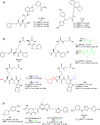Sirtuin modulators: past, present, and future perspectives
- PMID: 35583203
- PMCID: PMC9185222
- DOI: 10.4155/fmc-2022-0031
Sirtuin modulators: past, present, and future perspectives
Abstract
Sirtuins are NAD+-dependent protein lysine deacylase and mono-ADP ribosylases present in both prokaryotes and eukaryotes. The sirtuin family comprises seven isoforms in mammals, each possessing different subcellular localization and biological functions. Sirtuins have received increasing attention in the past two decades given their pivotal functions in a variety of biological contexts, including cytodifferentiation, transcriptional regulation, cell cycle progression, apoptosis, inflammation, metabolism, neurological and cardiovascular physiology and cancer. Consequently, modulation of sirtuin activity has been regarded as a promising therapeutic option for many pathologies. In this review, we provide an up-to-date overview of sirtuin biology and pharmacology. We examine the main features of the most relevant inhibitors and activators, analyzing their structure-activity relationships, applications in biology, and therapeutic potential.
Keywords: aging; cancer; drug discovery; epigenetics; metabolism; neurodegeneration; protein lysine deacylation; sirtuin modulators; sirtuins.
Conflict of interest statement
Financial & competing interests disclosure
This work was supported by FISR2019_00374 MeDyCa (A Mai), US National Institutes of Health n. R01GM114306 (A Mai), Progetto di Ateneo ‘Sapienza’ 2017 n. RM11715C7CA6CE53 and Regione Lazio Progetti di Gruppi di Ricerca 2020 – A0375-2020-36597 (D Rotili). The authors have no other relevant affiliations or financial involvement with any organization or entity with a financial interest in or financial conflict with the subject matter or materials discussed in the manuscript apart from those disclosed.
No writing assistance was utilized in the production of this manuscript.
Figures






Similar articles
-
Activation and inhibition of sirtuins: From bench to bedside.Med Res Rev. 2025 Mar;45(2):484-560. doi: 10.1002/med.22076. Epub 2024 Aug 31. Med Res Rev. 2025. PMID: 39215785 Free PMC article. Review.
-
Current Trends in Sirtuin Activator and Inhibitor Development.Molecules. 2024 Mar 6;29(5):1185. doi: 10.3390/molecules29051185. Molecules. 2024. PMID: 38474697 Free PMC article. Review.
-
Promising drug discovery strategies for sirtuin modulators: what lessons have we learnt?Expert Opin Drug Discov. 2021 Aug;16(8):915-927. doi: 10.1080/17460441.2021.1915980. Epub 2021 Apr 21. Expert Opin Drug Discov. 2021. PMID: 33880981 Review.
-
The role of structural biology in the design of sirtuin activators.Curr Opin Struct Biol. 2023 Oct;82:102666. doi: 10.1016/j.sbi.2023.102666. Epub 2023 Aug 4. Curr Opin Struct Biol. 2023. PMID: 37542908 Review.
-
Sirtuin functions and modulation: from chemistry to the clinic.Clin Epigenetics. 2016 May 25;8:61. doi: 10.1186/s13148-016-0224-3. eCollection 2016. Clin Epigenetics. 2016. PMID: 27226812 Free PMC article. Review.
Cited by
-
Sirtuins as Potential Targets for Neuroprotection: Mechanisms of Early Brain Injury Induced by Subarachnoid Hemorrhage.Transl Stroke Res. 2024 Dec;15(6):1017-1034. doi: 10.1007/s12975-023-01191-z. Epub 2023 Oct 2. Transl Stroke Res. 2024. PMID: 37779164 Free PMC article. Review.
-
LITAF inhibits colorectal cancer stemness and metastatic behavior by regulating FOXO1-mediated SIRT1 expression.Clin Exp Metastasis. 2023 Aug;40(4):309-320. doi: 10.1007/s10585-023-10213-x. Epub 2023 Jun 2. Clin Exp Metastasis. 2023. PMID: 37266842
-
Curcumin's Protective Role in Heatstroke-Induced Acute Liver Injury: Targeting Pyroptosis and Enhancing SIRT1 Expression.Glob Chall. 2024 Oct 13;8(12):2400178. doi: 10.1002/gch2.202400178. eCollection 2024 Dec. Glob Chall. 2024. PMID: 39679288 Free PMC article.
-
Novel Thiazole-Based SIRT2 Inhibitors Discovered via Molecular Modelling Studies and Enzymatic Assays.Pharmaceuticals (Basel). 2023 Sep 18;16(9):1316. doi: 10.3390/ph16091316. Pharmaceuticals (Basel). 2023. PMID: 37765125 Free PMC article.
-
First-in-Class Selective Inhibitors of the Lysine Acetyltransferase KAT8.J Med Chem. 2023 May 25;66(10):6591-6616. doi: 10.1021/acs.jmedchem.2c01937. Epub 2023 May 8. J Med Chem. 2023. PMID: 37155735 Free PMC article.
References
-
- Ho TCS, Chan AHY, Ganesan A. Thirty years of HDAC inhibitors: 2020 insight and hindsight. J. Med. Chem. 63(21), 12460–12484 (2020). - PubMed
-
- Mautone N, Zwergel C, Mai A, Rotili D. Sirtuin modulators: where are we now? A review of patents from 2015 to 2019. Expert Opin. Ther. Pat. 30(6), 389–407 (2020). - PubMed
-
- Fioravanti R, Mautone N, Rovere A et al. Targeting histone acetylation/deacetylation in parasites: an update (2017–2020). Curr. Opin. Chem. Biol. 57, 65–74 (2020). - PubMed
Publication types
MeSH terms
Substances
Grants and funding
LinkOut - more resources
Full Text Sources
Medical
Miscellaneous
